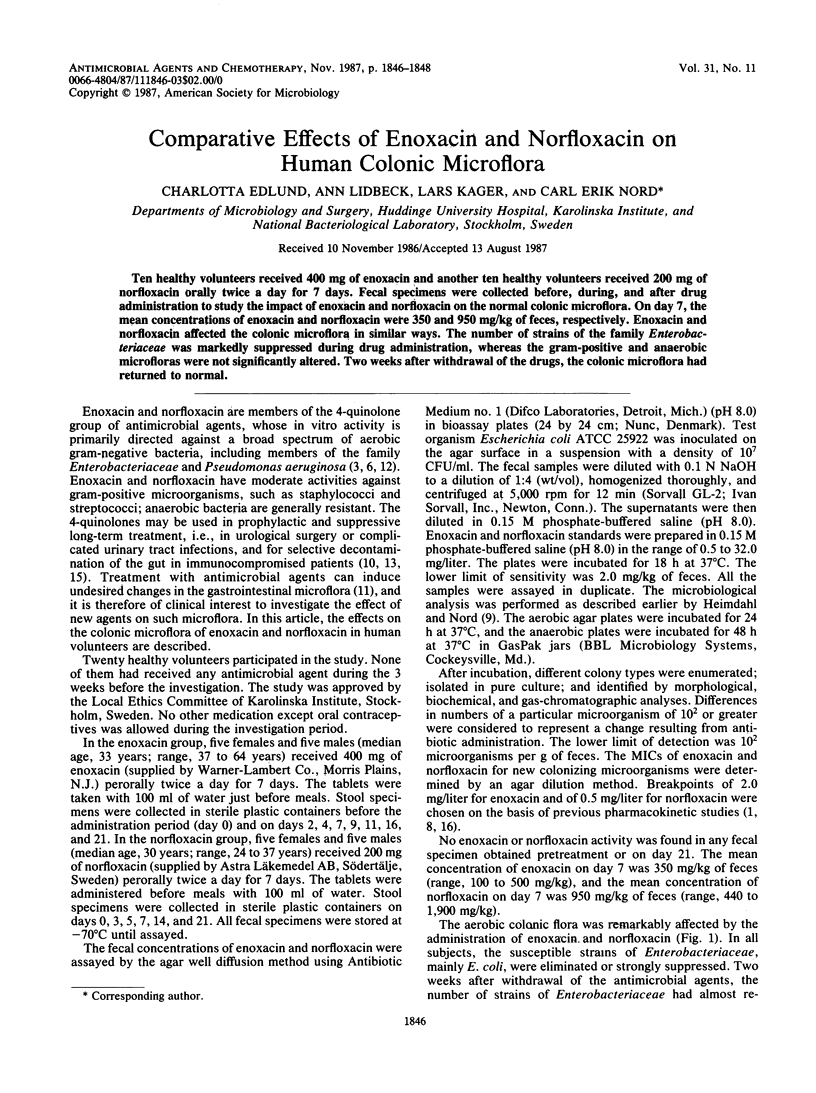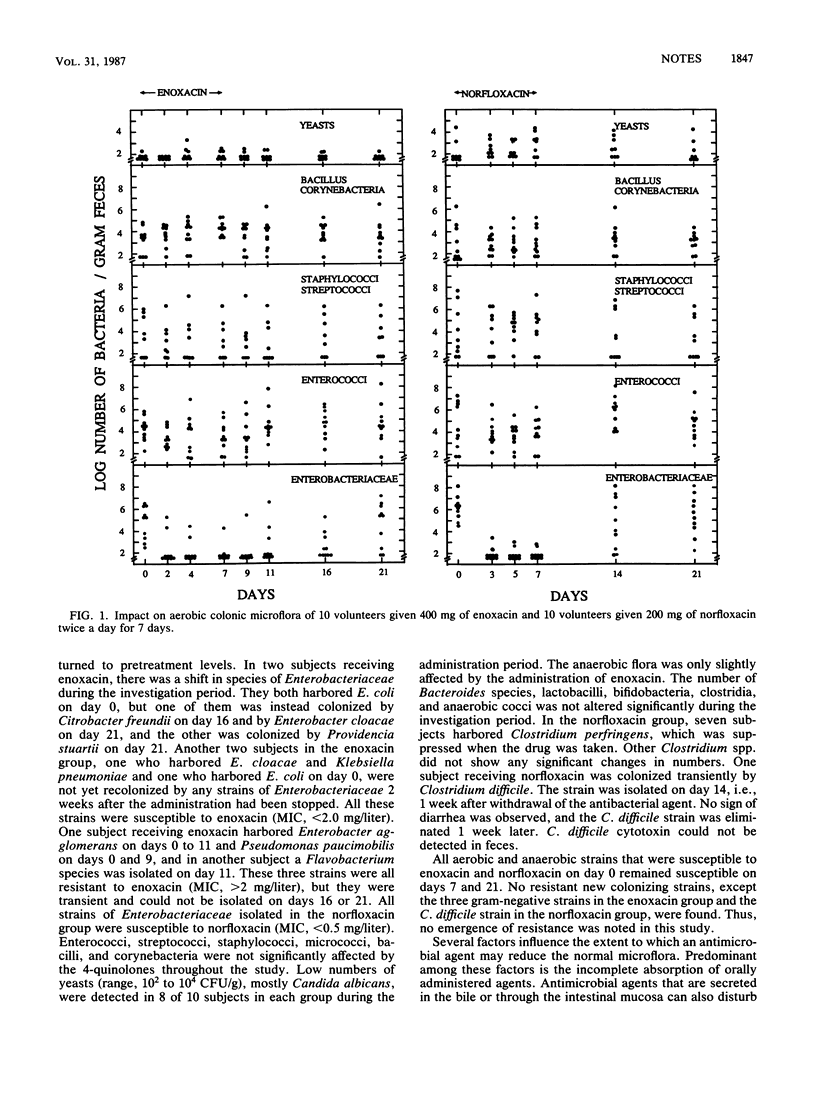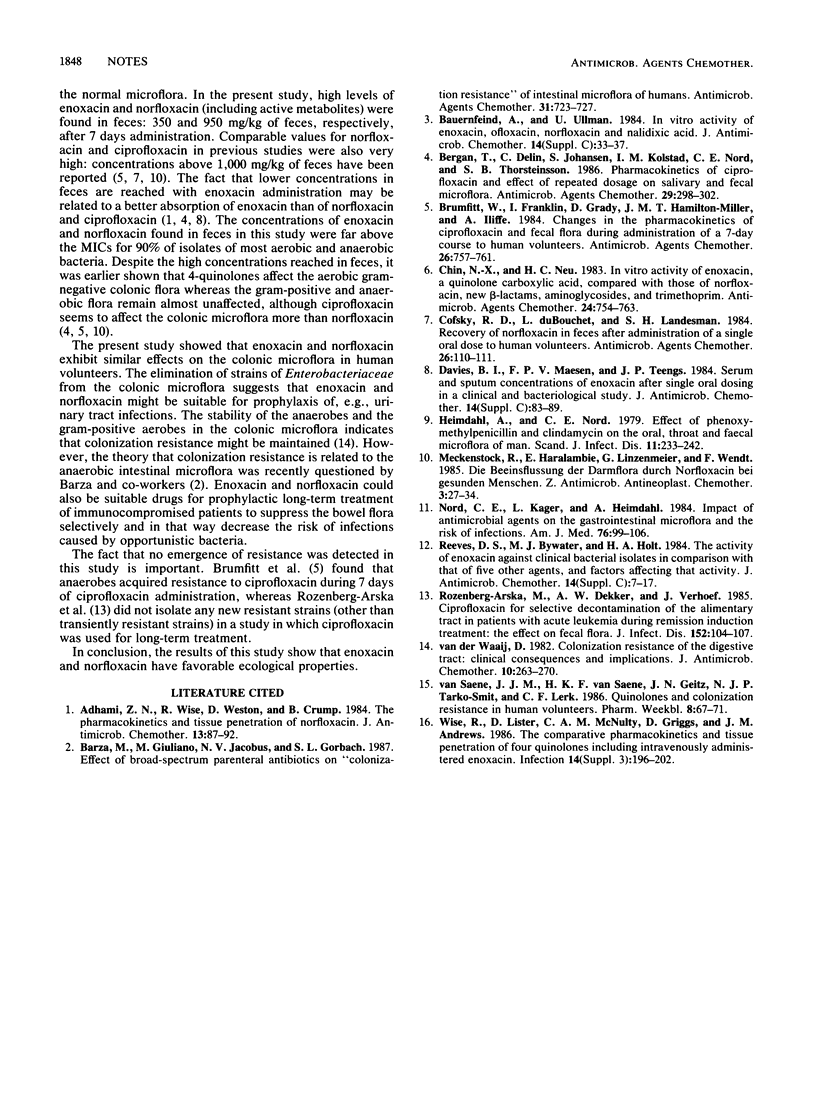Abstract
Ten healthy volunteers received 400 mg of enoxacin and another ten healthy volunteers received 200 mg of norfloxacin orally twice a day for 7 days. Fecal specimens were collected before, during, and after drug administration to study the impact of enoxacin and norfloxacin on the normal colonic microflora. On day 7, the mean concentrations of enoxacin and norfloxacin were 350 and 950 mg/kg of feces, respectively. Enoxacin and norfloxacin affected the colonic microflora in similar ways. The number of strains of the family Enterobacteriaceae was markedly suppressed during drug administration, whereas the gram-positive and anaerobic microfloras were not significantly altered. Two weeks after withdrawal of the drugs, the colonic microflora had returned to normal.
Full text
PDF


Selected References
These references are in PubMed. This may not be the complete list of references from this article.
- Adhami Z. N., Wise R., Weston D., Crump B. The pharmacokinetics and tissue penetration of norfloxacin. J Antimicrob Chemother. 1984 Jan;13(1):87–92. doi: 10.1093/jac/13.1.87. [DOI] [PubMed] [Google Scholar]
- Barza M., Giuliano M., Jacobus N. V., Gorbach S. L. Effect of broad-spectrum parenteral antibiotics on "colonization resistance" of intestinal microflora of humans. Antimicrob Agents Chemother. 1987 May;31(5):723–727. doi: 10.1128/aac.31.5.723. [DOI] [PMC free article] [PubMed] [Google Scholar]
- Bauernfeind A., Ullmann U. In-vitro activity of enoxacin, ofloxacin, norfloxacin and nalidixic acid. J Antimicrob Chemother. 1984 Sep;14 (Suppl 100):33–38. doi: 10.1093/jac/14.suppl_c.33. [DOI] [PubMed] [Google Scholar]
- Bergan T., Delin C., Johansen S., Kolstad I. M., Nord C. E., Thorsteinsson S. B. Pharmacokinetics of ciprofloxacin and effect of repeated dosage on salivary and fecal microflora. Antimicrob Agents Chemother. 1986 Feb;29(2):298–302. doi: 10.1128/aac.29.2.298. [DOI] [PMC free article] [PubMed] [Google Scholar]
- Brumfitt W., Franklin I., Grady D., Hamilton-Miller J. M., Iliffe A. Changes in the pharmacokinetics of ciprofloxacin and fecal flora during administration of a 7-day course to human volunteers. Antimicrob Agents Chemother. 1984 Nov;26(5):757–761. doi: 10.1128/aac.26.5.757. [DOI] [PMC free article] [PubMed] [Google Scholar]
- Chin N. X., Neu H. C. In vitro activity of enoxacin, a quinolone carboxylic acid, compared with those of norfloxacin, new beta-lactams, aminoglycosides, and trimethoprim. Antimicrob Agents Chemother. 1983 Nov;24(5):754–763. doi: 10.1128/aac.24.5.754. [DOI] [PMC free article] [PubMed] [Google Scholar]
- Cofsky R. D., duBouchet L., Landesman S. H. Recovery of norfloxacin in feces after administration of a single oral dose to human volunteers. Antimicrob Agents Chemother. 1984 Jul;26(1):110–111. doi: 10.1128/aac.26.1.110. [DOI] [PMC free article] [PubMed] [Google Scholar]
- Davies B. I., Maesen F. P., Teengs J. P. Serum and sputum concentrations of enoxacin after single oral dosing in a clinical and bacteriological study. J Antimicrob Chemother. 1984 Sep;14 (Suppl 100):83–89. doi: 10.1093/jac/14.suppl_c.83. [DOI] [PubMed] [Google Scholar]
- Heimdahl A., Nord C. E. Effect of phenoxymethylpenicillin and clindamycin on the oral, throat and faecal microflora of man. Scand J Infect Dis. 1979;11(3):233–242. doi: 10.3109/inf.1979.11.issue-3.11. [DOI] [PubMed] [Google Scholar]
- Nord C. E., Kager L., Heimdahl A. Impact of antimicrobial agents on the gastrointestinal microflora and the risk of infections. Am J Med. 1984 May 15;76(5A):99–106. doi: 10.1016/0002-9343(84)90250-x. [DOI] [PubMed] [Google Scholar]
- Reeves D. S., Bywater M. J., Holt H. A. The activity of enoxacin against clinical bacterial isolates in comparison with that of five other agents, and factors affecting that activity. J Antimicrob Chemother. 1984 Sep;14 (Suppl 100):7–17. doi: 10.1093/jac/14.suppl_c.7. [DOI] [PubMed] [Google Scholar]
- Rozenberg-Arska M., Dekker A. W., Verhoef J. Ciprofloxacin for selective decontamination of the alimentary tract in patients with acute leukemia during remission induction treatment: the effect on fecal flora. J Infect Dis. 1985 Jul;152(1):104–107. doi: 10.1093/infdis/152.1.104. [DOI] [PubMed] [Google Scholar]
- Van Saene J. J., Van Saene H. K., Geitz J. N., Tarko-Smit N. J., Lerk C. F. Quinolones and colonization resistance in human volunteers. Pharm Weekbl Sci. 1986 Feb 21;8(1):67–71. doi: 10.1007/BF01975484. [DOI] [PubMed] [Google Scholar]
- van der Waaij D. Colonization resistance of the digestive tract: clinical consequences and implications. J Antimicrob Chemother. 1982 Oct;10(4):263–270. doi: 10.1093/jac/10.4.263. [DOI] [PubMed] [Google Scholar]


